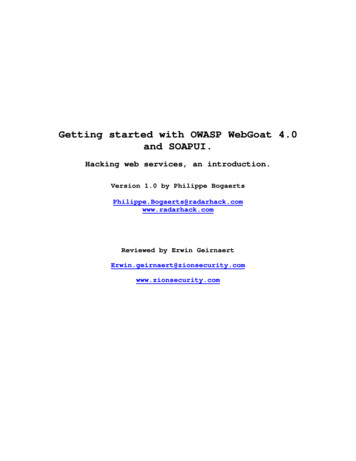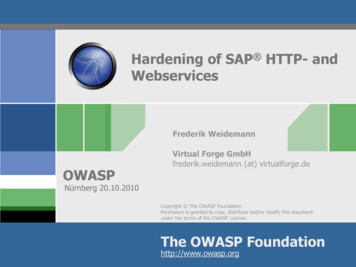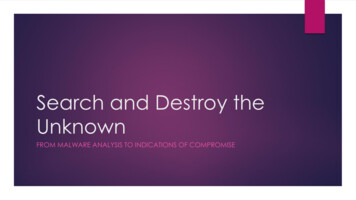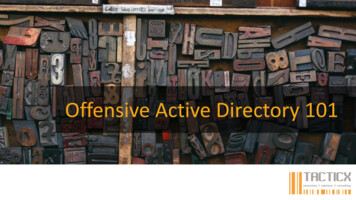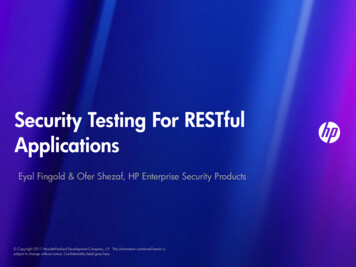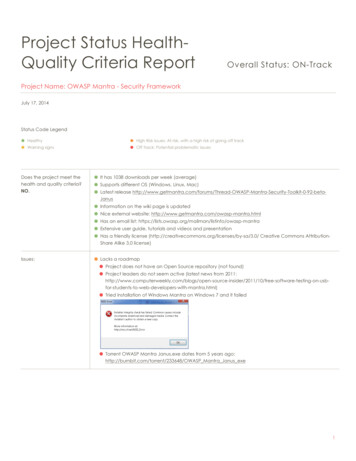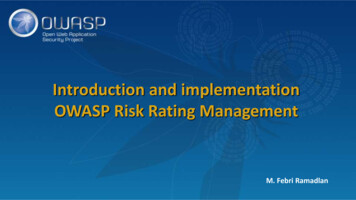
Transcription
Introduction and implementationOWASP Risk Rating ManagementM. Febri Ramadlan
About MeMohammad Febri Ramadlan (Ebi) is open source and information security enthusiast.Currently, He is IT Security Consultant in IndonesiaEbi also join some community such as OWASP, Code Security, Fowab (Forum Web Anak Bandung)Last of all, his hobbies is swimming, playing music, blogging, and part time travelling.Contact Person:: ( 62) 81809809636: mohammadfebriramadlan: mohammadfebrir@gmail.com: mohammadfebri.r: mohammadfebriramadlan: mohammadfebrir
Introduction OWASPRisk Rating Methodology
Risk Risk is hazards, consequences that may occur as a result of an ongoing process or futureevent.Risk factor:1. Intervension bad habit life style bankrupt2. Non-Intervension gen age sex
Risk ManagementRisk management is management process that encompasses the identification,evaluation and control of risk that may threaten the continuity of a business or acompany's activities.General Objectives: reduce expenditure, prevent companies from failure, increasecorporate profits, reduce production costs and many things.
Risk AssessmentRisk Assessment is methods performed to determine whether an activity / risk has anacceptable or not.Good assessment should to be done by a trained team and experienced.Each company or organization have variety of acceptance level.
Risk Rating MethodMany standard and guidance that will help you: TrikeAS/NZS 4360:2004 Risk ManagementCVSSOCTAVEOWASP Risk Rating Methodology
OWASP Risk Rating MethodologyLet's start with the standard risk model:Risk Likelihood * ImpactHow to use OWASP Risk Rating Methodology:#Step 1: Identifying a Risk#Step 2: Factors for Estimating Likelihood#Step 3: Factors for Estimating Impact#Step 4: Determining Severity of the Risk#Step 5: Deciding What to Fix#Step 6: Customizing Your Risk Rating Model
#Step 1: Identifying a RiskThe first step is:to identify a security risk that needs to be rated.
#Step 2: Factors for Estimating LikelihoodThere are a number of factors that can help determine the likelihood. The first set offactors are related to the threat agent involved. Skill level Motive Opportunity Size Ease of discovery Ease of exploit Awareness Intrusion detection
#Step 3: Factors for Estimating ImpactAgain, each factor has a set of options: Loss of confidentiality Loss of integrity Loss of availability Loss of accountability Financial damage Reputation damage Non-compliance Privacy violation
#Step 4: Determining the Severity of the Risk (1) Informal MethodLikelihood and Impact Levels0 to 3low3 to 6medium6 to 9high
#Step 4: Determining the Severity of the Risk (2) Repeatable e ofdiscoveryEase l Likelihood5.625Medium
#Step 4: Determining the Severity of the Risk (2) Repeatable e ofdiscoveryEase l Likelihood5.625Medium
#Step 4: Determining the Severity of the Risk (2) Repeatable Method (2)ImpactLoss ofconfidentialityLoss ofintegrityLoss ofavailabilityLoss 779Overall Impact7.0HighNoncompliance7Privacyviolation7
#Step 4: Determining the Severity of the Risk (2) Repeatable Method (2)ImpactLoss ofconfidentialityLoss ofintegrityLoss ofavailabilityLoss 779Overall Impact7.0HighNoncompliance7Privacyviolation7
#Step 4: Determining the Severity of the Risk (3) Determining SeverityOverall Risk MHIGHLowNOTELOWMEDIUMLowMediumHighLIKELIHOOD
#Step 4: Determining the Severity of the Risk (3) Determining SeverityOverall Risk MHIGHLowNOTELOWMEDIUMLowMediumHighLIKELIHOOD
#Step 5: Deciding What to FixAfter the risks to the application have been classified there will be a prioritized list ofwhat to fix.As a general rule, the most severe risks should be fixed first. It simply doesn't helpthe overall risk profile to fix less important risks, even if they're easy or cheap to fix.Remember that not all risks are worth fixing, and some loss is not only expected, butjustifiable based upon the cost of fixing the issue.
#Step 6: Customizing the Risk Rating ModelHaving a risk ranking framework that is customizable for a business is critical foradoption. Adding factorsCustomizing optionsWeighting factors
Tools
1. OWASP Risk Rating Template (excel format)https://www.owasp.org/images/5/5b/OWASP Risk Rating Template Example.xlsx
2. OWASP Risk Rating Calc (one 72bc0750af4d2e75c3a
3. OWASP Risk Rating Management(many wasp-riskrating
//category set by OWASP Top 10 - 2013
//you can assesst many website as you want (dynamic)
Question?
Thank you.
AS/NZS 4360:2004 Risk Management CVSS OCTAVE OWASP Risk Rating Methodology

